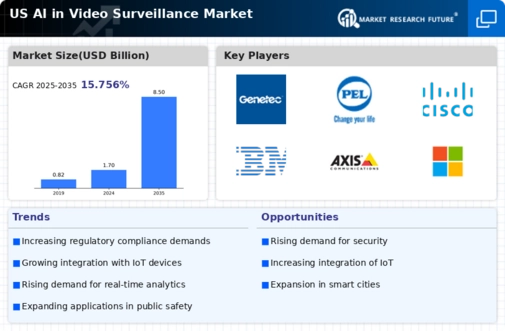Technological Advancements in AI
Rapid advancements in artificial intelligence technologies are significantly influencing the ai in-video-surveillance market. Innovations such as machine learning algorithms and deep learning techniques enhance the ability of surveillance systems to analyze video feeds in real-time. These technologies enable the identification of suspicious activities and the automation of monitoring processes, which can lead to a reduction in operational costs. By 2025, it is estimated that the integration of AI in surveillance systems could improve detection accuracy by over 30%, making them more effective than traditional methods. Consequently, the continuous evolution of AI technologies is likely to drive the adoption of advanced surveillance solutions across various industries.
Regulatory Compliance and Standards
The increasing emphasis on regulatory compliance and industry standards is a significant driver for the ai in-video-surveillance market. Organizations are compelled to adhere to stringent regulations regarding data protection and privacy, which necessitates the implementation of advanced surveillance systems that can ensure compliance. In the US, regulations such as the General Data Protection Regulation (GDPR) and various state-level privacy laws are shaping the market landscape. Companies are investing in ai-driven solutions that not only enhance security but also facilitate compliance with these regulations. This trend is expected to contribute to a market growth rate of approximately 12% annually as businesses seek to align their surveillance practices with legal requirements.
Increased Investment in Smart Cities
The push towards smart city initiatives is driving the demand for ai in-video-surveillance market solutions. As urban areas evolve, the integration of intelligent surveillance systems becomes crucial for managing public safety and infrastructure. Investments in smart city projects are projected to exceed $100 billion by 2025, with a significant portion allocated to advanced surveillance technologies. These systems are designed to monitor traffic, enhance public safety, and improve urban management. The growing focus on creating safer and more efficient urban environments is likely to propel the adoption of ai-driven surveillance solutions, thereby fostering market growth.
Rising Awareness of Crime Prevention
There is a growing awareness of the importance of crime prevention strategies among businesses and communities, which serves as a key driver for the ai in-video-surveillance market. Organizations are increasingly recognizing that proactive surveillance measures can deter criminal activities and enhance overall safety. This awareness is leading to a surge in investments in advanced surveillance technologies, with the market expected to grow at a CAGR of 14% through 2025. As stakeholders prioritize crime prevention, the demand for ai-driven surveillance systems that offer real-time analytics and actionable insights is likely to increase, further stimulating market expansion.
Growing Demand for Security Solutions
The increasing need for enhanced security measures across various sectors is a primary driver for the ai in-video-surveillance market. Organizations are investing heavily in advanced surveillance technologies to mitigate risks associated with theft, vandalism, and other criminal activities. In 2025, the market is projected to reach approximately $10 billion, reflecting a compound annual growth rate (CAGR) of around 15% from previous years. This surge is largely attributed to heightened awareness of security threats and the necessity for real-time monitoring capabilities. As businesses and public institutions prioritize safety, the demand for sophisticated ai-driven surveillance systems is expected to escalate, thereby propelling market growth.




















Leave a Comment